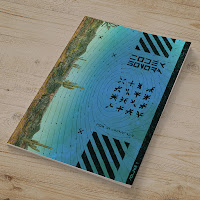Ah, crystals. I know what you think when you see crystals. New Age guru was not my intention, though. I wanted to depict something mineral, if only one subject, to make a footnote in my work that the Sonoran Desert is a wellspring of gems, precious metals, and beautiful minerals. Given that, yearly, I'm steps from giant tents of vendors and prospectors selling their gems and minerals at the
Tucson Gem & Mineral Show, I've become a fan. I also like following posts at the
Mineral Database, considering I know very little about the field. I do know there are hidden treasures in hard-to-find places here.
Walking along the surface of the desert in hilly or mountainous areas, the possibilities below your feet are reality. Chambers of water, fault lines ever moving, cavities filled with mineral formations, and spelunkers are still discovering immense cave systems. It was hard to pick one thing from the ground that symbolized it for me. Copper, turquoise, and silver are actively mined here. Meteorite finds are commonplace, given visible craters and the ease of spying them in bare earth areas, so the extraterrestrial angle was interesting. In the end, I settled on Amethyst.
As volcanic lava cools, it traps pockets of gas and silica-rich liquid to form Quartz crystals. If the liquid has trace amounts of iron and you wait millions of years, you get the purple-hued Amethyst. There is a background overlay in my piece of a sequential nonrepeating pattern echoing quartz's hexagonal base structure and organic growth. (Also, somewhere in there are some coordinates.)
I can't ignore the labeling of crystals with spiritual significance. It exists for many people. I can't ignore the monetary value put on them either, but I do. To me, unseen secrets below the ground flesh out the detail of the terrain, mimicking the rarity of natural life on the surface. It makes perfect sense to me.

















